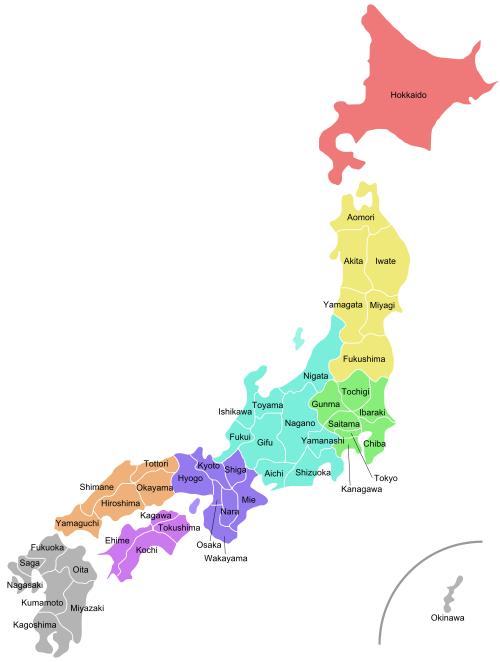http://www.japantravelinfo.com/news/news_item.php?newsid=431
http://www.jnto.go.jp/eq/eng/04_recovery.htm

stratovolcanic archipelago: four largest islands are Honshu, Hokkaido,Kyushu, and Shikoku (97% of Japan). Japan has the world's tenth-largest population
Japan is a member of the United Nations, the G7, the G8, and the G-20 major economies. Although Japan has officially renounced its right to declare war, it maintains a modern military with the world's eighth largest military budget
the Japanese population enjoying the highest life expectancy in the world and the infant mortality rate being the third lowest globally.[11][12][13]
About 73 percent of Japan is forested, mountainous, and unsuitable for agricultural, industrial, or residential use
Japan has 108 active volcanoes. Destructive earthquakes, often resulting in tsunami, occur several times each century.[78] The 1923 Tokyo earthquake killed over 140,000 people.[79] More recent major quakes are the 1995 Great Hanshin earthquake and the 2011 Tōhoku earthquake, a 9.0-magnitude[80] quake which hit Japan on March 11, 2011, and triggered a large tsunami.[52] Due to its location in the Pacific Ring of Fire, Japan is substantially prone to earthquakes and tsunami, having the highest natural disaster risk in the developed world.[81]

Japan's population is more than 127 million,[2] with 80% of the population living on Honshū. Japanese society is linguistically and culturally homogeneous
In 2003, there were about 134,700 non-Latin American Western and 345,500 Latin American expatriates, 274,700 of whom were Brazilians (said to be primarily Japanese descendants, or nikkeijin, along with their spouses),[149] the largest community of Westerners.[151]
Japan suffers from a high suicide rate.[169][170] In 2009, the number of suicides exceeded 30,000 for the twelfth straight year.[171] Suicide is the leading cause of death for people under 30.[172]
Japanese is an agglutinative languagedistinguished by a system of honorifics reflecting the hierarchical nature of Japanese society, with verb forms and particular vocabulary indicating the relative status of speaker and listener. Japanese writing uses kanji (Chinese characters) and two sets of kana (syllabaries based on simplified Chinese characters), as well as the Latin alphabet andArabic numerals.
The earliest works of Japanese literature include the Kojiki and Nihon Shokichronicles and the Man'yōshū poetry anthology, all from the 8th century and written in Chinese characters.[201][202] In the early Heian period, the system ofphonograms known as kana (Hiragana and Katakana) was developed. The Tale of the Bamboo Cutter is considered the oldest Japanese narrative.[203] An account of Heian court life is given in The Pillow Book by Sei Shōnagon, whileThe Tale of Genji by Murasaki Shikibu is often described as the world's first novel.[204][205]
During the Edo period, the chōnin ("townspeople") overtook the samurai aristocracy as producers and consumers of literature. The popularity of the works of Saikaku, for example, reveals this change in readership and authorship, while Bashō revivified the poetic tradition of the Kokinshū with his haikai (haiku) and wrote the poetic travelogue Oku no Hosomichi.[206] The Meiji era saw the decline of traditional literary forms as Japanese literature integrated Western influences. Natsume Sōseki and Mori Ōgai were the first "modern" novelists of Japan, followed by Ryūnosuke Akutagawa, Jun'ichirō Tanizaki, Yukio Mishima and, more recently, Haruki Murakami. Japan has two Nobel Prize-winning authors—Yasunari Kawabata (1968) and Kenzaburō Ōe (1994).[203]
Japanese cuisine is based on combining staple foods, typically Japanese rice ornoodles, with a soup and okazu — dishes made from fish, vegetable, tofu and the like – to add flavor to the staple food. In the early modern era ingredients such as red meats that had previously not been widely used in Japan were introduced.
Traditionally, sumo is considered Japan's national sport.[209] Japanese martial arts such as judo, karate and kendo are also widely practiced and enjoyed by spectators in the country. After the Meiji Restoration, many Western sports were introduced in Japan and began to spread through the education system.[210]Japan hosted the Summer Olympics in Tokyo in 1964. Japan has hosted the Winter Olympics twice: Sapporo in 1972 and Nagano in 1998.[211] Tokyo will host the 2020 Summer Olympics, making Tokyo the first Asian city to host the Olympics twice.
Baseball is currently the most popular spectator sport in the country.
Language in Japan[edit]
Main article: Languages of Japan
- Japanese language
- Japanese dialects
- Kansai dialect
- Saga-ben
- Wasei-eigo (Japanese English)
- Ryukyuan languages
- Foreign Variations
- Writing systems of Japan
No comments:
Post a Comment